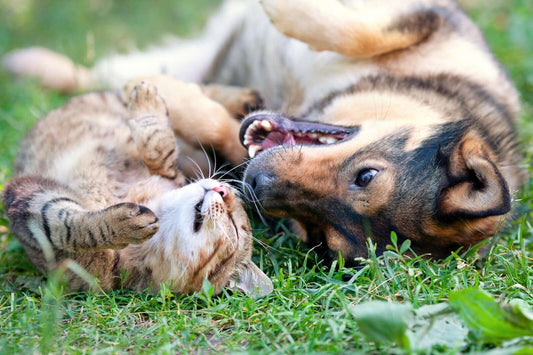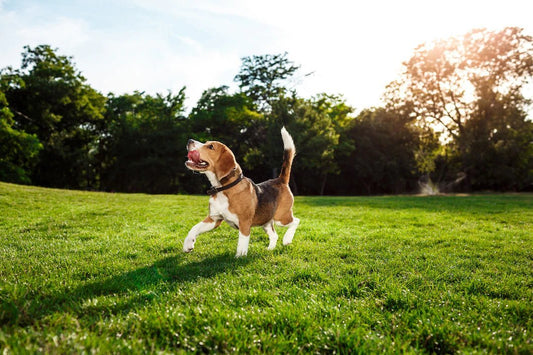Ever wondered why your furry friend sometimes acts a bit, well, peculiar? Don't worry, you're not alone! In this guide, we're jumping into the world of common dog behaviour problems. From barking too much to chewing up your favourite shoes, our pups sure know how to keep us on our toes. By understanding these behaviours and addressing them early on, we can create happier, healthier relationships with our doggos. So, grab a treat (for you and your pup!) and let's sniff out some solutions together!
Separation Anxiety
Understanding Separation Anxiety:
Separation anxiety is a condition where dogs feel frightened and lonely when separated from their beloved human companions. This often occurs in dogs that form strong bonds with one particular person. When left alone, they may experience panic because they don't understand that their human will return.
Signs of Separation Anxiety:
There are clear signs that a dog is experiencing separation anxiety. These include pacing, excessive barking, whining, destructive behaviour, and accidents indoors. However, their issues usually subside once their human returns, making it easier to recognize this condition.
Helping Dogs with Separation Anxiety:
There are several ways to assist dogs in coping with separation anxiety. Gradually increasing the duration of alone time, providing engaging puzzle toys, playing calming music, and, if necessary, consulting with a veterinarian about medication are all effective approaches. Having a calm demeanour during departures and arrivals and implementing training techniques can gradually build the dog's confidence in being alone.

Aggression:
Types of Aggression:
Aggression in dogs can show in various forms, including fear aggression, territorial aggression, and possessive aggression. Each type of aggression may stem from different underlying causes and may require different approaches for resolution.
Causes and Triggers:
Understanding the root causes and triggers of aggression is key in addressing this behaviour. Factors such as past trauma, lack of socialisation, fear, and territorial instincts can contribute to aggressive tendencies in dogs. Identifying specific triggers, such as meeting unfamiliar people or animals, can help in developing specific intervention strategies.
Behaviour Modification and Training Techniques:
Behaviour modification techniques and positive reinforcement training are effective approaches for managing aggression in dogs. This may involve desensitization exercises, counter-conditioning, and teaching alternative behaviours to replace aggressive responses. Seeking guidance from a professional dog trainer or behaviourist can provide valuable insights and support in implementing these techniques effectively.

Excessive Barking:
Reasons for Excessive Barking:
Dogs bark as a way of communication, but excessive barking can become a problem. Common reasons for excessive barking include boredom, loneliness, territorial behaviour, or responding to external stimuli like other dogs or noises. Understanding the underlying cause of the barking is important in addressing this behaviour effectively.
Training Methods to Reduce Barking:
Training techniques focused on teaching alternative behaviours and rewarding quiet behaviour can help reduce excessive barking. Positive reinforcement, such as treats or praise, can be used to reinforce calm and quiet behaviour. Consistent training and patience are key in modifying barking behaviour over time.
Environmental Management Tips:
Creating a non-triggering environment can also help minimize excessive barking. Providing mental stimulation through interactive toys, regular exercise, and companionship can alleviate boredom and reduce barking. Minimizing exposure to stimuli that trigger barking, such as closing curtains to block visual stimuli or using white noise machines to mask outdoor sounds, can help manage excessive barking episodes.

Destructive Chewing:
Understanding the Root Causes:
Dogs chew as a natural behaviour, but destructive chewing can occur when they're bored, anxious, or teething. Understanding why your dog is chewing destructively is the first step in addressing this behaviour. It could be due to lack of mental stimulation, separation anxiety, or simply exploring their environment.
Providing Proper Chew Toys and Alternatives:
Offering appropriate chew toys and alternatives can redirect your dog's chewing behaviour onto acceptable items. Choose toys made specifically for chewing, such as durable rubber or nylon toys, and avoid items that resemble household objects to prevent confusion. Rotate toys regularly to keep your dog engaged and provide variety.
Training Techniques to Redirect Chewing Behaviour:
Training techniques focused on redirection and positive reinforcement can help modify destructive chewing behaviour. Encourage your dog to chew on designated toys by offering praise and treats when they engage with them. Consistently redirecting your dog's attention away from inappropriate items and towards acceptable chew toys reinforces the desired behaviour over time.

Jumping Up:
Reasons for Jumping Up Behaviour:
Dogs often jump up to greet people as a way of showing excitement and seeking attention. They may also jump up to get closer to faces for sniffing or to access food or toys. Understanding the reasons behind this behaviour can help in addressing it effectively.
Training Methods to Discourage Jumping:
Training methods focused on teaching alternative behaviours and setting boundaries can help discourage jumping up. Techniques such as turning away or ignoring the dog when they jump, providing a sit command as an alternative greeting behaviour, or using a leash to prevent jumping can be effective in curbing this behaviour.
Consistency and Positive Reinforcement:
Consistency is key when addressing jumping up behaviour. Everyone in the household should follow the same rules and reinforcement techniques to avoid confusion. Positive reinforcement, such as offering treats and praise when the dog remains calm and greets people politely, can encourage the desired behaviour and reinforce the training efforts.

Pulling on the Leash:
Reasons for Leash Pulling:
Dogs may pull on the leash due to excitement, curiosity, or a desire to explore their surroundings. Sometimes, they pull because they haven't been taught proper leash manners or because they are eager to reach something they find interesting.
Training Techniques for Loose Leash Walking:
Training techniques aimed at teaching loose leash walking can help address leash pulling behaviour. These techniques often involve rewarding the dog for walking calmly beside their owner without pulling. Methods such as stopping and changing direction when the dog pulls, using verbal cues and rewards to encourage desired behaviour, and gradually increasing distractions during walks can be effective in teaching loose leash walking.
Tools and Equipment to Aid in Training:
Using tools and equipment designed to aid in training, such as front-clip harnesses or head halters, can also be beneficial when teaching a dog to walk politely on a leash. These tools provide additional control and can help redirect the dog's attention away from pulling. However, it's essential to use such equipment properly and in conjunction with positive reinforcement training methods for the best results.

Fear and Anxiety:
Identifying Signs of Fear and Anxiety:
Dogs display various signs when they're experiencing fear and anxiety, such as trembling, panting, pacing, hiding, or excessive drooling. Some dogs may also exhibit behaviours like cowering, growling, or attempting to escape from the situation. Recognizing these signs is essential for understanding your dog's emotional state and addressing their needs effectively.
Desensitization and Counterconditioning:
Desensitization and counterconditioning are techniques used to help dogs overcome their fears and anxieties gradually. Desensitization involves exposing the dog to the feared stimulus in a controlled and gradual manner, starting with a low-intensity version of the trigger and gradually increasing exposure as the dog becomes more comfortable. Counterconditioning involves pairing the feared stimulus with something positive, such as treats or praise, to change the dog's emotional response from fear to relaxation or enjoyment.
Creating a Safe and Comfortable Environment:
Creating a safe and comfortable environment is crucial for helping fearful and anxious dogs feel secure. This includes providing a quiet and predictable routine, offering a designated safe space where the dog can retreat when feeling overwhelmed, and minimizing exposure to known triggers whenever possible. Providing mental stimulation, regular exercise, and plenty of positive reinforcement can help boost your dog's confidence and reduce overall anxiety levels.

If you feel that your dog has severe aggressive behaviour, then seeking professional help from a certified dog trainer or behaviourist is a must. These experts can provide tailored guidance and support to address your dog's specific needs and ensure long-term success in managing their behaviour. Remember, with patience, consistency, and the right resources, you can help your furry friend overcome any behaviour challenges.











